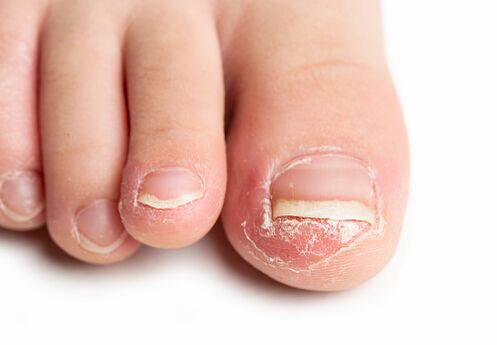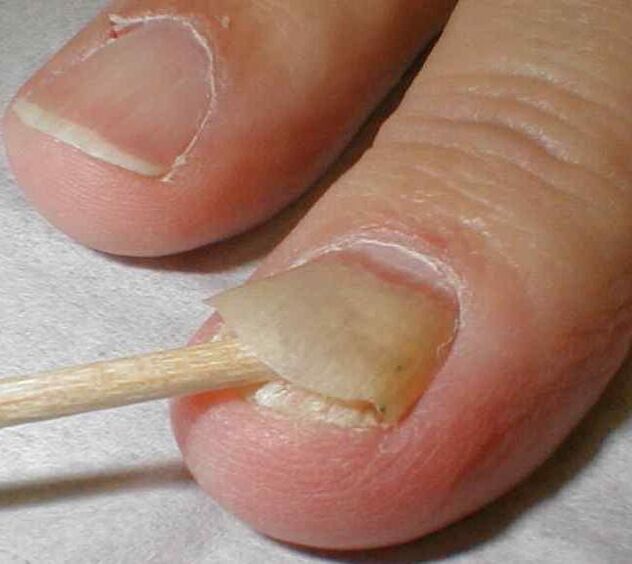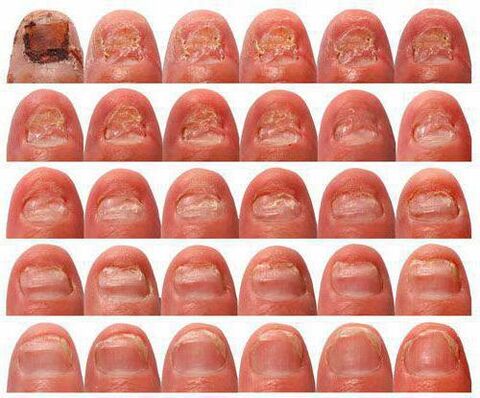This article will focus on such an uncomfortable but unfortunately quite common phenomenon as toenail fungus. The symptoms and causes of this disease are known to medicine and can be easily diagnosed at all stages. However, it can only be determined with a careful attitude towards one's own health. How do I identify toenail fungus? How is it to be treated? Are the advertised ointments effective?

What causes nail fungus?
Nail fungus is a fairly common disease. The disease spreads particularly successfully in places with a temperate and tropical climate, that is, where it is humid and warm. Paradoxically, however, residents of cold countries are most likely to develop nail fungus. This is because in harsh climates you have to wear warm shoes with socks at all times. The foot sweats, the sock gets wet and the person has to stay in this state for a long time without having the opportunity to change shoes. This is the best way to encourage nail fungus formation. Before we talk about how to identify toenail fungus, let's find out who is more prone to this disease.
Nail fungus as an occupational disease
At risk are people whose feet cannot breathe during the day due to tight shoes. These are miners, power plant workers, gardeners and representatives of other work specialties. The fungus can be "picked up" by working in the laundry, pool, hotel or restaurant.
What diseases can serve as a prerequisite
Often not only representatives of the professions mentioned above suffer from this disease, but also people with type 1 or type 2 diabetes mellitus. In addition, deformities of the feet and varicose veins can be a prerequisite for the formation of nail fungus. One of the causes of this infection is inadequate nail nutrition due to a blockage or blockage in the blood vessels. For this reason, the creams advertised today, as well as nail varnishes, which were supposedly developed to protect against fungi, are completely useless in the fight against diseases. After all, it is often caused by internal ailments, and external influences will not eliminate problems.
Who is at risk?
A few decades ago, in most cases, nail fungus was diagnosed in the elderly. However, every year the number of patients suffering from nail fungus is increasing, and the disease itself is getting younger.
Official data shows that nail fungus is two to three times more likely to develop in men. At the same time, women with this problem are much more likely to turn to a dermatologist. The fairer sex is more concerned about its health and will not find anything shameful in consulting a doctor.
Next, we will consider why it is so important to get recommendations on how to treat the fungus from a dermatologist, and we will talk about how to identify the fungus on the nails and what symptoms it has at each stage of its development.

What does nail fungus look like?
This disease is not fatal, but, of course, it is necessary to get rid of it. Fortunately, it is easy for anyone to recognize the onset of an illness. How do you recognize mushrooms on your feet? You can find tips below. First, take a closer look at your nails.
The first thing to look out for is this nail color. The nail affected by the fungus turns dull yellow and opaque. Depending on the stage of the disease, the edge of the nail plate, the base, or the entire nail can be affected.
Pay attention to the thickness of the nail
In answering the question of how to determine nail fungus, changes in the nail plate should also be mentioned. Despite the fact that due to the disease, the nail visually thins, and sensations make it appear thicker and more swollen.
How do I identify nail fungus? To determine the presence of infection, a visual examination of the nail plate is not enough. Mix potassium permanganate and water in a ratio of 1 to 5 and dip your nails in the resulting solution for half a minute. The healthy nail will be colored and brown. Part of the affected plate remains white.
Stages of the disease
The disease has four stages. The sooner you start treatment, the more likely it is that you will get rid of nail fungus permanently.
The first stage is characterized by damage to the edge of the nail. As mentioned above, the plate changes color, bulges appear. The nail grows of poor quality, hollow, and therefore breaks and crumbles.
An increase in the lesion area becomes a sign of the second stage. It should also be noted that sometimes the second stage can begin as if bypassing the first. The defeat of the nail plate begins not from the edge, but from the base of the nail. It will be more problematic to recover from nail fungus in the second stage than the first.
How do I identify stage 3 toenail fungus? In medicine, it is called a white surface fungus and looks like the entire plate has been affected. It has a dense white color, strongly crumbles on the edges.
The fourth stage is called total dystrophic fungus. The nail is yellowish-gray in color, exudes a peculiar unpleasant smell and crumbles badly. In the fourth stage, you can often see the exposed part of the skin under the broken nail as it has grown due to the fungus and in most cases it is breaking off.

Often the reason for contacting a dermatologist is to independently identify the fourth stage of nail fungus. Don't look for advice on how to treat nail fungus effectively in forums or the internet. It is better to consult a specialist at the first symptoms of the disease.
What can you expect from a visit to the doctor?
Probably there is fear of doctors in each of us. However, don't be afraid to contact a dermatologist if you suspect you have nail fungus. The specialist will conduct an external exam and also scrape the upper stratum corneum of the nail to send to the laboratory for diagnosis. A detailed analysis will reveal what became the causative agent of the disease, determine the type of fungus and tell the doctor what type of treatment should be prescribed.
Treatment of a nail fungus takes a long time. It can take anywhere from a month to three. You will need to do tests again after treatment, even if the above symptoms are not observed.
A few words about effective treatment
So now we know how to identify toenail fungus. The methods are given above. Now it is worth saying a few words about the treatment that you can do yourself. The drug Naftifine has proven itself quite well. However, you do not need to use an ointment, but a solution. This drug can also be used for athlete's foot infections.
How do you use naftifin? If you have a fungus in the first stage of the disease, then lubricate the affected surface of the nail twice a day. Keep your nails dry and well washed. In the next stages of the disease, you can not do without taking pills. In this case, however, the use of naftifine should not be stopped. This increases the effectiveness of the medicine.
Before applying the product, thoroughly clean the affected surface of the nail with a manicure device. However, you need to be extremely careful when doing this. After perfect manipulations, it is necessary to apply naftifine solution to the cleaned area. Repeat 2 times a day.
Sum up
The article provides an answer to the question of how to identify toenail fungus. However, it is worth remembering that self-medication does not always lead to full recovery. If the thickness or color of your nails changes, you should consult a doctor.
Depending on the degree of damage to the nail plate, the fungus can be divided into four stages. If the disease does not raise the alarm at the first stage, since it does not deform the nail plate much, then at the fourth stage you can easily lose your nails. Do not hesitate to contact a dermatologist.
You are strongly advised not to self-medicate and succumb to advertising messages about the effectiveness of any particular drug. Cream or any other agent that is applied to the nail plate from the outside does not get rid of the causative agent of the disease, and therefore is ineffective. As a result, you only delay the treatment process and mask the manifestation of the disease. Also, it should not be forgotten that the nail fungus not only looks unaesthetic, but is also a kind of beacon that indicates the presence of disorders in the body.


















